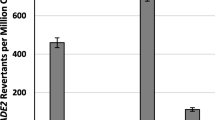Abstract
Specific binding ofNicotiana nuclear protein(s) to subterminal regions of theAc transposable element was detected using gel mobility shift assays. A sequence motif (GGTAAA) repeated in both terminal regions ofAc, was identified as the protein binding site. Mutation of two nucleotides in this motif was sufficient to abolish binding. Based on a series of competition assays, it is deduced that there is cooperative binding between two repeats, each similar to the GGTAAA motif. The binding protein is probably similar to a previously characterized maize protein which binds to a GGTAAA-containing motif located in the ends ofMutator. Moreover, we show that DNA fromDs1 competes for protein binding toAc termini, and we show, by sequence analysis, that GGTAAA binding sites are present in the terminal region ofTgm1, Tpn1, En/Spm, Tam3 andDs1-like elements. This suggests that the binding protein(s) might be involved in the transposition process.
Similar content being viewed by others
References
Banks JA, Masson P, Fedoroff N (1988) Molecular mechanisms in the developmental regulation of the maizeSuppressor-mutator transposable element. Genes Dev 2:1364–1380
Beall EL, Admon A, Rio DC (1994) ADrosophila protein homologous to the human p70 Ku autoimmune antigen interacts with theP transposable element inverted repeats. Proc Natl Acad Sci USA 91:12681–12685
Becker HA, Kunze R (1996) Binding sites for maize nuclear proteins in the subterminal regions of the transposable elementActivator. Mol Gen Genet 251:428–435
Berg DE, Howe MM (1989) Mobile DNA. American Society for Microbiology, Washington DC
Calvi BR, Hong TJ, Findley SD, Gelbart WM (1991) Evidence for a common evolutionary origin of inverted repeat transposons inDrosophila and plants:hobo, Activator, andTam3. Cell 66:465–471
Chandler VL, Walbot V (1986) DNA modification of a maize transposable element correlates with loss of activity. Proc Natl Acad Sci USA 83:1767–1771
Chatterjee S, Starlinger P (1995) The role of subterminal sites of transposable elementDs ofZea mays in excision. Mol Gen Genet 249:281–288
Coupland G, Plum C, Chatterjee S, Post A, Starlinger P (1989) Sequences near the termini are required for transposition of the maize transposonAc in transgenic tobbacco plants. Proc Natl Acad Sci 86:9585–9388
Ellis JG, Finnegan EJ, Lawrence GJ (1992) Developing a transposon tagging system to isolate rust resistance genes from flax. Theor Appl Genet 85:46–54
Fedoroff NV (1989) About maize transposable elements and development. Cell 56:181–191
Greenblatt IM, Brink RA (1963) Transposition ofModulator in maize into divided and undivided chromosome segments. Nature 197:412–413
Hehl R, Baker B (1990) Properties of the maize transposable elementActivator in transgenic tobacco plants: a versatile inter-species genetic tool. Plant Cell 2:709–721
Jones JDG, Carland FM, Maliga P, Dooner HK (1989) Visual detection of transposition of the maize elementActivator (Ac) in tobacco seedlings. Science 244:204–207
Kunze R, Starlinger P (1989) The putative transposase of transposable elementAc fromZea mays L. interacts with subterminal sequences ofAc. EMBO J 8:3177–3185
Laski FA, Rio DC, Rubin GM (1986) Tissue specificity of DrosophilaP element transposition is regulated at the level of mRNA splicing. Cell 44:7–19
Levy AA, Walbot V (1990) Regulation of the timing of transposable element excision during maize development. Science 248:1534–1537
McLaughlin M, Walbot V (1987) Cloning of a mutablebz2 allele of maize by transposon tagging and differential hybridization. Genetics 117:771–776
Meller Y, Sessa G, Eyal Y, Fluhr R (1993) DNA-protein interactions on a cis-DNA element essential for ethylene regulation. Plant Mol Biol 23:453–463
Rio DC, Rubin GM (1988) Identification and purification of aDrosophila protein that binds to the terminal 31-base-pair inverted repeats of theP transposable element. Proc Natl Acad Sci 85:8929–8933
Schmidt R, Willmitzer L (1989) The maize autonomous elementActivator (Ac) shows a minimal germinal excision frequency of 0.2%–0.5% in transgenicArabidopsis thaliana plants. Mol Gen Genet 220:17–24
Schwartz D, Dennis EA (1986) Transposase activity of theAc controlling element in maize is regulated by its degree of methylation. Mol Gen Genet 205:476–482
Scott V, Clark A, Docherty K (1994) The gel retardation assay. In: Harwood AJ (ed) Methods in molecular biology. Humana Press, Totowa, New Jersey
Siebel CW, Rio DC (1990) Regulated splicing of theDrosophila P transposable element third intron in vitro: somatic repression. Science 248:1200–1208
Sutton WD, Gerlach WL, Schwartz D, Peacock WJ (1984) Molecular analysis ofDs controlling element mutations at theAdh1 locus of maize. Science 223:1265–1268
Walbot V (1990) Evidence for somatic sectoring early in aleurone development with thebzl-mul allele. Maize Genet Coop Newslett 64:107
Yang C-H, Carroll B, Scofield S, Jones J, Michelmore R (1993) Transactivation ofDs elements in plants of lettuce (Lactuca sativa). Mol Gen Genet 241:389–398
Yoder JI (1990) Rapid proliferation of the maize transposable elementActivator in transgenic tomato. Plant Cell 2:723–730
Zhao Z, Sundaresan V (1991) Binding sites for maize nuclear proteins in the terminal inverted repeats of theMul transposable element. Mol Gen Genet 229:17–26
Author information
Authors and Affiliations
Additional information
Communicated by H. Saedler
Rights and permissions
About this article
Cite this article
Levy, A.A., Fridlender, M., Hanania, U. et al. Binding ofNicotiana nuclear proteins to the subterminal regions of theAc transposable element. Molec. Gen. Genet. 251, 436–441 (1996). https://doi.org/10.1007/BF02172372
Received:
Accepted:
Issue Date:
DOI: https://doi.org/10.1007/BF02172372




